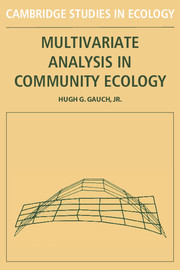Summary
In this book multivariate analysis in community ecology has been reviewed and the theory, methods, and applications of direct gradient analysis, ordination, and classification have been presented. In conclusion, a few comments will be offered concerning inherent limitations, model accuracy, and prospectus.
Several inherent limitations should be acknowledged in community ecology. They may be mitigated in part by strenuous efforts but cannot be eliminated. These limitations must be recognized or the likely result will be unrealistic and ineffective research. (1) Community ecology field data are noisy. (2) Multivariate analysis summarizes community data and functions because numerous species abundances are controlled largely by a relatively small number of environmental and historical factors. The word largely is required, however, because each species is unique and individual (Gleason 1926; Whittaker, Levin, & Root 1973; Macfadyen 1975; Mclntosh 1975, 1980; Simberloff 1980; Strong 1980), and likewise, each site and each environmental factor are to some degree unique. Consequently, any general community description, even the best possible such description, can capture only a fraction of the total variation. In contrast, the objects of other sciences may be more uniform, such as in chemistry, where trillions of atoms of carbon or iron may be treated as identical for many purposes. (3) Community ecology is partially subjective. The origins of subjectivity include the choices of research purposes and perspectives, the field data collection procedures, the multivariate analyses, and the methods of interpreting the results.
- Type
- Chapter
- Information
- Multivariate Analysis in Community Ecology , pp. 242 - 245Publisher: Cambridge University PressPrint publication year: 1982



